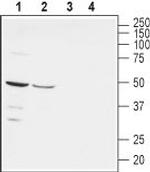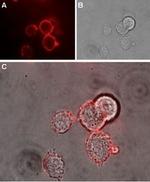Search Thermo Fisher Scientific
Alomone Labs, LTD
Nectin-1/PVRL1 (extracellular) Polyclonal Antibody
FIGURE: 1 / 5
Nectin-1/PVRL1 (extracellular) Antibody (ANR-051-200UL) in WB





Product Details
ANR-051-200UL
Species Reactivity
Host/Isotype
Class
Type
Immunogen
Conjugate
Form
Concentration
Purification
Storage buffer
Contains
Storage conditions
Shipping conditions
Product Specific Information
Reconstitution: 1 X 25 µL double distilled water (DDW), depending on the sample size. The antibody ships as a lyophilized powder at room temperature. Upon arrival, it should be stored at -20C. The reconstituted solution can be stored at 4C for up to 1 week. For longer periods, small aliquots should be stored at -20C. Avoid multiple freezing and thawing. Centrifuge all antibody preparations before use (10000 x g 5 min).
Target Information
This gene encodes an adhesion protein that plays a role in the organization of adherens junctions and tight junctions in epithelial and endothelial cells. The protein is a calcium(2+)-independent cell-cell adhesion molecule that belongs to the immunoglobulin superfamily and has 3 extracellular immunoglobulin-like loops, a single transmembrane domain, and a cytoplasmic region. This protein acts as a receptor for glycoprotein D of herpes simplex viruses 1 and 2, and pseudorabies virus and mediates viral entry into epithelial and neuronal cells. Mutations in this gene cause cleft lip and palate/ectodermal dysplasia 1 syndrome as well as non-syndromic cleft lip with or without cleft palate. Alternative splicing results in multiple transcript variants encoding proteins with distinct C-termini.
For Research Use Only. Not for use in diagnostic procedures. Not for resale without express authorization.
References (0)
Bioinformatics
Protein Aliases: CD111; ectodermal dysplasia 4 (Margarita Island type); herpes simplex virus type 1 sensitivity; Herpes virus entry mediator C; Herpesvirus entry mediator C; Herpesvirus Ig-like receptor; HIgR; nectin 1; Nectin cell adhesion molecule 1; nectin); Nectin-1; nectin-1 alpha; nectin-1 delta; poliovirus receptor-like 1; poliovirus receptor-related 1 (herpesvirus entry mediator C; poliovirus receptor-related 1 (herpesvirus entry mediator C); poliovirus receptor-related 1 (herpesvirus entry mediator C; nectin); Poliovirus receptor-related protein 1
Gene Aliases: AI835281; AW549174; CD111; CLPED1; ED4; HIgR; HV1S; HVEC; nectin-1; NECTIN1; OFC7; PRR; PRR1; PVRL1; PVRR; PVRR1; SK-12
UniProt ID: (Human) Q15223, (Mouse) Q9JKF6
Entrez Gene ID: (Human) 5818, (Rat) 192183, (Mouse) 58235

Performance Guarantee
If an Invitrogen™ antibody doesn't perform as described on our website or datasheet,we'll replace the product at no cost to you, or provide you with a credit for a future purchase.*
Learn more
We're here to help
Get expert recommendations for common problems or connect directly with an on staff expert for technical assistance related to applications, equipment and general product use.
Contact tech support
